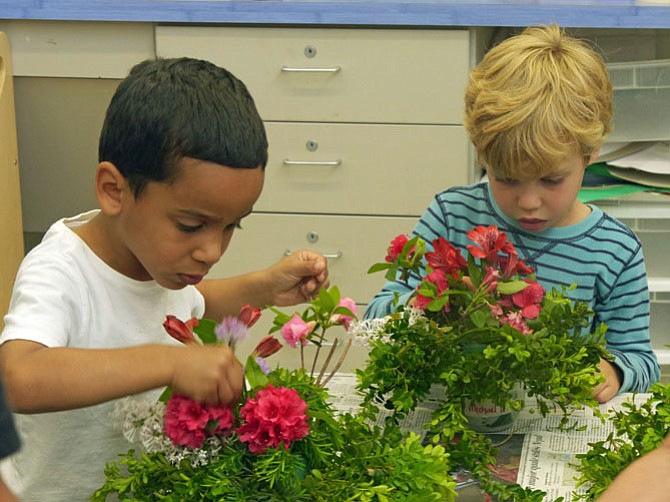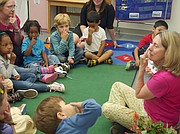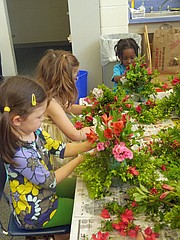Two preschoolers in the garden therapy class at Glebe Elementary focus on the final touches of their hummingbird arrangement. Photo by Shirley Ruhe/The Connection
The door swings open and 12 pre-schoolers skip to the corner and sit themselves in a circle. It is the monthly half-hour garden therapy session at Glebe Elementary in Arlington. Mary Cottrell, chair of the Garden Therapy Committee at the Rock Spring Garden Club, said this concept was started over 30 years ago and has been running ever since.
Glebe Principal Jamie Borg says this is a preschool special education class with peer models. The children who receive special education services have been identified as having a disability and the peer models are specially selected from the neighborhood. They serve as friends to the students modeling play skills and language. Borg added, "we learned early on that while we can model play and communication with kids, it is learned much faster and authentically by a peer."
This session is about hummingbirds. Connie Richards, who is in charge of the May presentation, says they will read about hummingbirds and then make bouquets of flowers that hummingbirds would like. She opens the book: "Show me your nose. Do you think you could get your nose into a flower?"
The next page describes male and female hummingbirds. "Who knows the difference? Well, a male hummingbird has an iridescent throat. That means it is shiny." Richards goes on, "The female isn't as pretty but has an Important job. She lays the eggs and protects them and later feeds the chicks nectar from the flower."
She continues with hummingbird body parts. "What do we call our wings? Right — arms. Can you flap your wings?" The room comes alive with arms moving up and down. Finally to the theme of the day: "Hummingbirds like flowers shaped like trumpets. " And the room is filled with a cacophony of sound.
Now to the table where each place has a small, green spongy Oasis cube that will hold the arrangement. "First start with the green twigs.” Everyone has a different vision with some green twigs all on top, others around the edges. When all are satisfied with the first step, one of the Garden Club volunteers places the pink azaleas in the center of the table mixed with some white honeysuckle. "And smell this," Mary Nell Bryant said, holding out a lilac branch in front of a small nose. Earnest faces concentrate on the effort; some share stems with each other.
And each child has an original creation to take home with the final thought: "Remember hummingbirds like colorful flowers."



